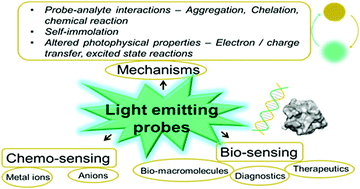Light emitting probes – approaches for interdisciplinary applications
Abstract
Though the field of fluorescent sensors has been known for more than 150 years, tremendous developments were made in the past two decades with the emergence of fluorescence-based optical sensors that are now inevitable tools for sensing a variety of biological, chemical and environmental analytes. These probes are simple, highly sensitive, selective and specific towards detection. There are several unique mechanisms adopted by these probes towards sensing analytes. This tutorial review introduces various fluorescent probes that are being employed in the development of chemo- and bio-sensors for the detection of various charged and neutral species, including biomacromolecules like proteins and nucleic acids. This review mainly focuses on basic principles involved in the design of probes with different sensing methods like self-immolation, peptide beacon, FRET, photo-induced electron/charge transfer, etc. The complexity observed in biological systems with interference from numerous other analytes and the necessity to use multiple probes was overcome by using multiple responsive probes. Herein we have discussed the design and sensing mechanism of various probes that find applications in physical, chemical and biological sciences, diagnostics and therapeutics.



 Please wait while we load your content...
Please wait while we load your content...